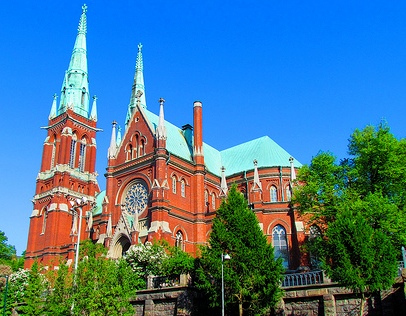

St. John's Church (Swedish: Johanneskyrkan) is a neo-Gothic
church of the Evangelical Lutheran Swedish-speaking Johannes
församling, formerly the Helsinki Cathedral Parish, in
Ullanlinna, Helsinki, in the southern part of the city
center along Korkeavuorenkatu. The church was built between
1888 and 1891, and its tallest parts are the 74-meter-high
towers at the northeast end. The church was designed by
Stockholm architect Adolf Emil Melander, whose proposal won
a competition organized in 1878. The church can accommodate
2,600 people, and it is the largest stone church in Finland
in terms of seats. The church is the main example of Finnish
neo-Gothic churches. The altarpiece is a Heavenly View
painted by Eero Järnefelt in 1932. Its subject is the
conversion of Saul of Tarsus, or Apostle Paul, who
persecuted the disciples of Jesus, to Christianity on the
road to Damascus. There are three bells in the church. The
church was consecrated by the bishop of Porvoo, Carl Henrik
Alopaeus, on December 13, 1891. On the front wall of the
church is Kari Juva's sculpture Johannes Kastaja from 2004.
The church is surrounded by Johannesenpuisto, which has
grassy areas, a playground and a sand field, which is frozen
into a skating rink in winter.
At the time St. John's Church was built, Punavuori was still a poor
area, where the building stock consisted of small wooden houses. The
building of the church was partially motivated by a counter-attention to
the orthodox Uspenski Cathedral, as neo-Gothic architecture was used to
emphasize the western roots of Finnishness. At the same time, due to the
growing population of Helsinki, a new church was needed.
Architect Melander himself designed the church pews, pulpit, altar
equipment and baptismal font. The decoration uses a lot of the
three-leaf clover motif, which is a typical Gothic symbol of the Holy
Trinity. The interior of the church is very decorative with stained
glass windows, arched windows, hymnals and chandeliers. Originally, the
church's greenish-grey, plastered wall surfaces also had decorative
patterns on their upper parts and on the arch. In later restorations
(the first time in 1913), the patterns were covered with a light uniform
color.
After the Helsinki City Parish was divided in 1906, St.
John's Church was used by both the southern Finnish and the southern
Swedish congregations of Helsinki. The name of the first mentioned was
changed to John's parish in 1956, but in 1999 it was merged with the
Helsinki cathedral parish.
The church was restored for its
centenary celebration, and then a part of the old layer of decorative
painting was revealed on the wall of the gallery. The church was damaged
in the heavy bombing of Helsinki in February 1944; among other things,
several windows were broken.
The organ was originally built by the German organ factory E.F.
Walcker in 1891, and has been remodeled in 1921, 1937, 1956 and 1974. It
has 66 voices, which are distributed over three fingers and a foot. In
2005, the German organ builder Orgelwerkstatt Christian Scheffler
restored the organ and restored the disposition designed by Oskar
Merikanno.
Among others, Oskar Merikanto, Armas Maasalo, Tauno
Äikaä and Pertti Eerola have worked as church organists. The first
cantor of the church was Abraham Ojanperä, and after him, Sulo Saarits
has performed the cantor's duties, among others.
St. John's
Church plays a significant part in the Advent celebration of many
Helsinki residents. The advent concerts of the Viipur Lauluveikot men's
choir have been held almost every year in St. John's church since the
beginning. The choir's 50th Advent concert was held in St. John's Church
in 2003. Tauno Äikää and Pertti Eerola have served as organists for the
concerts, among others.
St. John's Church has been the filming location for many domestic television and film productions. The most famous is Yle TV1's drama series Kotikatu (1995–2012), which in its early days was set in the surroundings of a church, and the church served as one of the factors that connected the series' characters.